The Royal Navy’s first-in-class Type 31 frigate, HMS Venturer, has officially rolled out from the build hall at Babcock’s Rosyth dockyard — a major milestone in the £1.25 billion Inspiration-class programme.
This morning’s operation saw the 5,700-tonne vessel emerge for the first time from the purpose-built Venturer Building, where she has been under construction since 2021. The event marks the transition from structural assembly to the next critical phases: float-off, combat systems integration, and sea trials.
Sir Nick Hine KCB, Chief Executive of Babcock’s Marine division, spoke to me about the project and described the roll-out as a landmark moment for the programme.
“We’ll take her from where she is behind us on the hard standing, we’ll put her on the barge, and we’ll take her into dock. She’ll be in dock in the next sort of 10 days or so. And we put her into dock because that’s the best place to do more fit-out work. So we’ll fit her out over the next sort of six to nine months. And then once we’ve done that, we’ll look to start vessel acceptance, and we hope to start having that done in the next sort of 12 months — handover to the Navy. I mean, I’d hand her over to the Navy as quickly as we can.”
A former Royal Navy Second Sea Lord, Sir Nick joined Babcock in 2022 following a distinguished military career commanding submarines, surface ships, and operational deployments. He was appointed Chief Executive, Marine, in 2024 and now oversees the company’s naval shipbuilding and export operations, including support for AUKUS and global outreach.
After entering the dock in the coming days, Venturer will begin an intensive fitting-out period in No. 3 dry dock, where her main sensor mast, weapons systems, and mission equipment will be installed. Much of her internal outfitting has already been completed under cover. The roll-out was intentionally postponed to allow more interior work to be completed in a controlled environment — a decision aimed at improving efficiency and quality.
The ship will be placed on the CD01 barge, the same submersible platform that was used to float HMS Glasgow and HMS Cardiff into the water on the Clyde. Once Venturer is on board, the barge will submerge and lower the ship into the water. She will then be moved a short distance across the basin to begin her final outfitting phase.
This image via Dave Cullen, provided to us with permission, shows the vessel now going on the barge.
Integration of her combat systems will now begin in earnest.
Sir Nick also spoke to me the programme’s momentum, noting that the project is proceeding faster than many comparable efforts.
“It’s going much faster than any other shipbuilding programme in the UK or anywhere in the world, actually, in terms of complex warships. As I say — five in service from contract in 10 years is astonishing. Could I go faster? Probably. Would I like to go faster? Yes, of course — because the Navy needs the ships, and these will be vital elements of national security. So I’d like to deliver that as quickly as possible.”
The second ship in the series, HMS Active, is already structurally complete, and the third, HMS Formidable, is progressing through early construction. Sir Nick noted he is always pushing for more progress.
“Those people who know me will know nothing in the world ever goes fast enough for me. I’ve already said to the team, ‘We’ve got one out today — why isn’t number three in the yard?’”
With the Type 31 programme reaching peak production tempo, attention is also turning to what lies ahead for Rosyth once the five ships are complete. Babcock has invested over £200 million in the site’s shipbuilding infrastructure and workforce, including a new warehouse and expanded training programmes. Sir Nick made clear that keeping that momentum going is now his top priority.
“Let’s be really clear — I’m on record as saying I want to sell 31 Type 31s by 2031. I want to make sure this is a programme that lasts and runs, and we get the benefit of all the investment that we’ve made here: the £200 million we’ve put into Babcock and into our site; the skilled workforce we now have here; the engineers; the apprentice programme we run; our production service operatives. All of those things are clearly dependent on work.”
“So whilst my team build ships as well as you can see here today, it’s my job to go and win work. I need to win work and persuade the UK Government that it needs more platforms like this, and I need to persuade other governments that they need platforms like this. But I am convinced that this is the ship that navies need.”
The Inspiration-class is designed to replace the Royal Navy’s ageing Type 23 general-purpose frigates and to serve as flexible, globally deployable assets. Venturer’s delivery will be followed by one ship per year, with all five vessels expected to be in service by 2030 — an achievement that, if met, would set a new benchmark for naval shipbuilding in the UK.


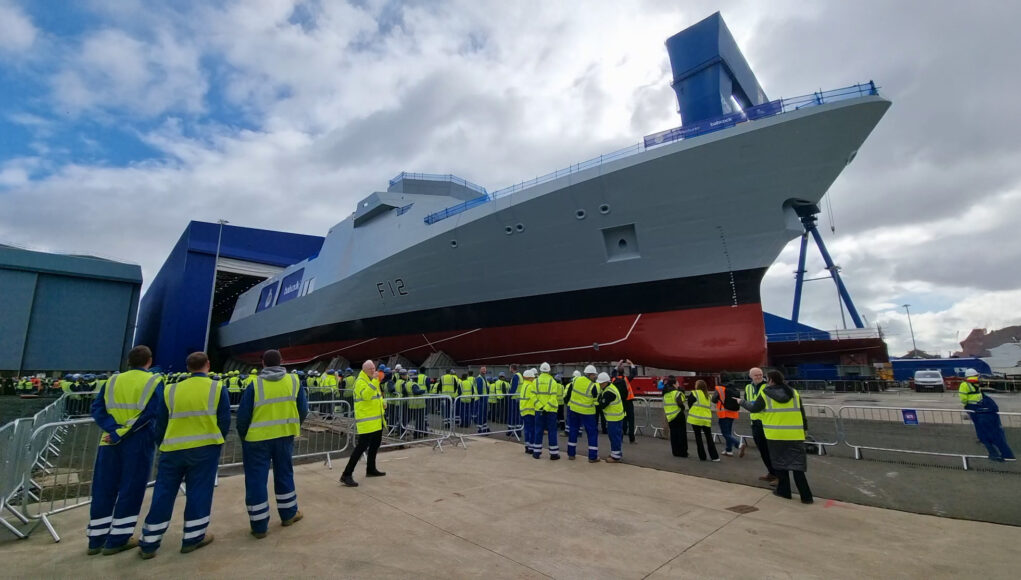

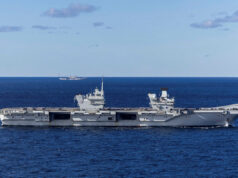
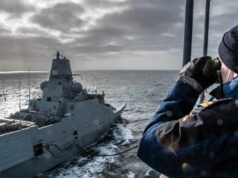
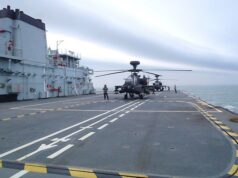

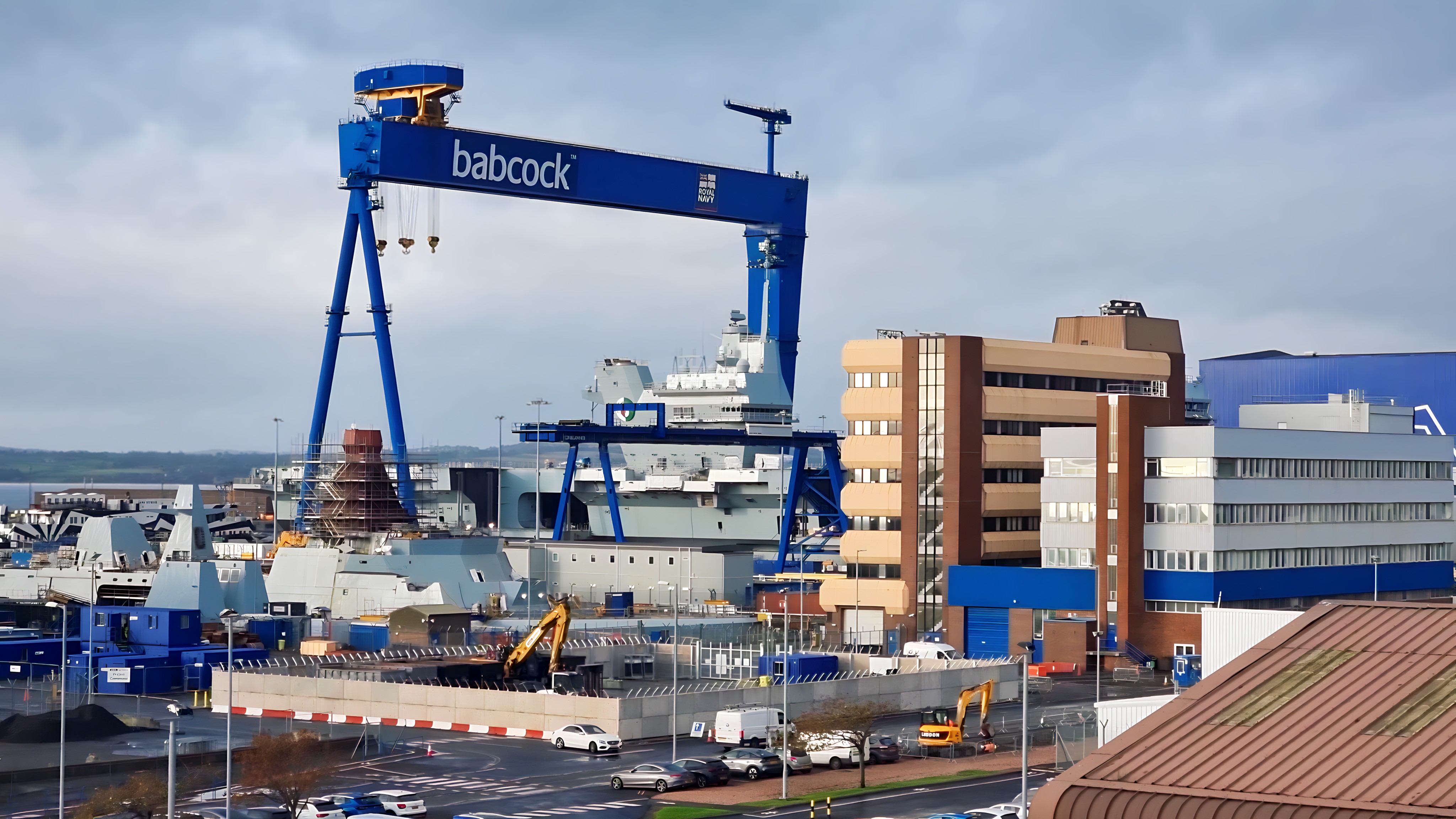
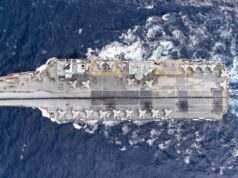


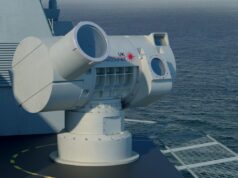

“It’s going much faster than any other shipbuilding programme in the UK or anywhere in the world, actually, in terms of complex warships.”
China on line one.
if it rains they’ll probably put back inside again. can’t get it wet.
Hush yourself. They’re starting ship 3 assembly now it’s out
if it rains they’ll probably put back inside again. can’t get it wet. I wondered how far along the active buile I.s.
First in class is normally slower. Promising.
China on line one.
Japan, Korea , Italy, France…
It’s “sort of good in a sort of good way, sort of like venturing forth into the forth, sort of”.
“This is just the sort of thing we have been waiting for”.
back and forth😁.
HMS Backhand, perhaps. Forth is in the Falklands.
Jon, please do try to keep up.
Must admit it sounded more like a street urchin than a former 2nd Sea Lord.
Interesting pennant number.
Though heaven knows how the RN picks them. I see no system.
Great to see such a smart ship being rolled out. I’ve noted the RN are using the lower Pennant number for this GP frigate; I seem to recall this was the arrangement for the T21s and T22s ….. T21 had the lower numbers, the T22s the higher? Also, if you look on the NL website they show a few more pics; any ideas what the panel is for on the transom, just above the stern pennant?
Probably access to the mission space below the flight deck.
Poop locker fer the poopdeack. I thank yew….🇬🇧🙃🕳️ btth.
Access Hatch for the deployment of the SSTD System.
?? SSTD….solid shit to dump.Systemic humour failure 😏.🇬🇧 FlyNavy 🕳️🙃 btth.
Great to see. Any confirmation of how many VLS she will have on entering service – is it indeed 12? And also at what stage she will receive Mk41 – eg before or after acceptance by the RN?
My take is, the first 2 or 3 T31s won’t get Mk41 before acceptance, this is something that will follow on, perhaps when Frigate 4, “Bulldog”, is nearing completion. Trying to shoe-horn their fitting into the current programme will only lead to delays, for which Babcock and the MoD would be slated for, if they tried to! As far as the quantity of Mk41 per ship …. using Wikipedia as a reference ….. ” …… On 17 May 2023, the First Sea Lord Ben Key stated that Type 31 frigates would in fact be fitted with the 32-cell Mark 41 Strike-Length complex. The exact missile mix for the Type 31 with the Mark-41 has yet to be confirmed but will likely eventually consist of at least 32x Sea-Ceptor missiles quad-packed into one of the four 8-cell launch modules in addition to possibly integrating the forthcoming surface launched variant(s) of the Future Cruise/Anti-Ship Weapon(s) …..”
Did he say the number of silos after a press question, because I looked at the transcript of the speech and he never mentioned numbers, just that the t31 would have them after the t26 are fully fit out?
” …The exact missile mix for the Type 31 with the Mark-41 has yet to be confirmed but will likely eventually consist of at least 32x Sea-Ceptor missiles quad-packed into one of the four 8-cell launch modules…”
Unlikely, CAMM will be arrange as quad-packed for Mk.41 on T31! Even on Billion £’s T26, we are seeing the return of 6 cell ‘Mushroom Farm’ complexs!
The great thing is they will all end up the MK41s fitted, it makes the difference from being lightly armed “Patrol frigate” to a ship that can get into near-peer fights with other vessels and /or provide standoff land attack capabilities.
Of course, the lack of bow sonar still seems like a bit of an oversight, but maybe UUVs can do that job ?
The curious part is in the speach he said all t26 would receive them and then said 5 of the t31 would. Wonder if that means they plan for an additional order of ships.
Good spot. Increasing the order from 5 to 8 could enable the first 3 to be configured as MCM motherships i.e. just 12 Sea Ceptor and a working deck above the mission bay and maybe a crane. The next 5 would have the Mk41 silos which would occupy most of the deck and mean a smaller mission bay I think.
FIVE MORE PLEASE, and name one of them HMS Starling.
And HMS Glowworm please!
Glowworm is good. Rammed the Hipper as I recall. The reason for my choice is that my father served with Capt. Johnnie Walker right through the war, firstly on HMS Stork and then HMS Starling with 2SG. Eighteen U Boats betwwen them.
Warspite
Black Swan
Achilles
Ajax
Revenge
Warspite and Achilles are taken!
HMS Cockchafer
HMS Starling was a Black Swan class and we might need Ajax.
HMS Pansy – there used to be such a vessel. Flower Class corvette
No, they renamed it Heartease before launching.
HMS Surprise is needed.
As well as Broadsword, Battleaxe and Bloodhound.
Master and Commander? Cracking film.
I think the ship in Master and Commander was HMS Sophie.
Nah, it was HMS Surprise.
Cracking film.
Nope, it was HMS Surprise in books and the film, but whether they had a Sophie onboard is another thing…
Geoff and Lusty:
Nope. Master and Commander, the first book in the Aubery-Maturin stories has Jack Aubery in Command of HMS Sophie, a small Sloop of War that’s he commands on convoy duty and prize missions in the Med for the entire book (minus a tiny bit at the end). He doesn’t take command of HMS Surprise until the third book (titled HMS Surprise), even then it doesn’t remain, Aubery takes Command of Bellona later in the series (though after an unrealistically long stint on HMS Surprise).
Also wouldn’t call it a cracking film.
GHGood point, but it will always be HMS Surprise.
Cracking film. Cracking film cracking film cracking film. Don’t take life to seriouslyyyyyyyyyy.
Also why start with an I think and then launch into a lecture you pillarbox of a person
Dern is a see you next tuesday type of person
“Why start with I think and then launch into a lecture.”
Because I was going off memory and when multiple people jumped on me I opened Master and Commander and checked, then came back with receipts.
Seriously, you’re throwing insults because I bothered to check the book? Grow the fuck up.
Great to see real progress on these ships and much quicker than the t26 . We just need HM government to keep the production rolling now and lets build the RN numbers back up
Brilliant, brilliant, now let’s keep um coming!
Another batch. Needed now. Give us ten of these ships and ten type 26.
Pull your finger out HMG
With an estimated £60-80Bn in tax cuts coming if Nigel gets into Downing St – raising the minimum salary before paying tax to 20k/yr, scraping the 2 child benefit limit, returning the WFA to old folk – it will be interesting to see where the money comes from more more shiny ships. ‘Efficiency; saving don’t even come close to paying. Brexit costing the economy 4% of GDP and associated tax loss
Absolutely, there wouldn’t be any big increases in defence spending under Reform plc. Farage is both too in thrall to Putin and far too keen on tax cuts (deficit financed, as per Liz Truss) for that to happen.
Reform plc’s vote is high correlated with areas suffering from high levels of deprivation, disability and sickness, and which are understandably desperate for change.
I feel a bit sorry for these people. Brexit has failed to do anything to improve their lives (as was obvious from the beginning) and the same would be true of a Reform plc Government (which plans to finance a tax cut by reducing spend on the very things these areas make the most use of i.e. pensions, benefits and healthcare).
None of the other options are great but until we can get the economy growing again and productivity improving (finally!), everything else is a bit moot anyway.
For all the criticism of Reform and Farage as populist he is the only politician who perceives that the fundamental problem with the UK is demographics: the indigenous population has so little faith in themselves and hope for the future that they do not stay married, have babies and raise children. We keep the economy going on immigrants and pets. Immigrants by and large the retain family values and hope that too many ‘natives’ have lost. The dog population is about 13 million and cats about the same while NHS maternity services deteriorate. As the Americans would say, go figure. If a Martian were to land in the UK he would think we are a country which hates children, mothers and families. This is the underlying reason we struggle with economic growth. It’s also the reason the armed forces struggle to recruit….we just don’t want to do things that are good for us.
If a government wants to increase the birthrate then all that is required is giving free IVF those under 40. The problem is people are having kids late which leaves little time to then have more.
The birth rate amongst Brits dropped from the early 1970s onwards, probably due to introduction of the Pill in late 1960s. Interestingly, this point in time also marked the start of the decades’ long house price inflation which now means that housing is as expensive for the average person as it was back the 1880s.
Families stopped having so many children, women entered the workforce and more lax lending rules allowed these larger family incomes to be used to take out larger mortgages (and push up house prices). Incomes also grew massively in real terms during the 1970s so while we remember the strikes and black-outs, the 1970s was actually a decade of growing affluence.
In short, the drudge of bringing up lots of children was out and increased consumerism (holidays, homes, cars) was in! Hurrah! Remember, there is no such thing as a free lunch.
This drop in the birth rate had a massive impact on the UK’s demographics. In a parallel universe where we’d both maintained the pre-1970s birth rate and stopped the levels of immigration we’ve experienced since 2003, the UK population would be even higher than it is now (but weirdly house prices might be much lower).
My complaint of Farage and his ilk is that he portrays the issue of immigration as simple and any solutions as cost free. All choices come with trade-offs, including this one. If we want to stop any more immigrants from coming here and even go further by encouraging those already here to leave, that’s fine by me but there’s a cost to doing that. Again, only scammers try to tell that there is such a thing as a free lunch!
For example, if all the post-2003 immigrants hadn’t come and stayed, we’d now have the oldest population in Western European and that would mean we would have even fewer young workers than we do now to fund the retirements and healthcare of retirees. Denmark, which has done much to heavily reduce the flow of immigrants has just decided that it needs to increase the state pension age to 70. These two things are two sides of the same coin.
I could personally accept a democratically based decision to cut back on immigration even though we’d end up with a lower tax base and so need to make cuts to pensions and healthcare. I hope all of us making that decision would be mature enough to accept the consequences as part and parcel of our decision.
I doubt it though, as we have already seen with Brexit. The economic consequences of Brexit seem, by common consent of the independent think-tanks, to have settled out at c.2.5% lost GDP per year and a consequent loss of c.£40bn in tax revenue. Not great but not fatal.
Now I would respect people saying this is a price worth paying for our political freedom (even though that’s not completely true) but the people who pushed Brexit will not take any responsibility for their own actions. It’s like listening to Communists who say that it’s never failed as an ideology because it’s never been properly tried: “Brexit isn’t delivering what we expected because it’s not a proper Brexit, you know, the one in our imaginations”.
Yeah, right. So, don’t pretend that your choices in life don’t have consequences; it’s part of being a grown-up that you stop believing in fairy-tales.
Yes, the Pill was a pivotal piece of technology: it breaks the link between actions and consequences. The other pivotal change was the decision to take a wife’s earnings into account for a mortgage: since land is held and hoarded by a few, all that did was inflate house prices and put married couples on a treadmill.
The guys just Trump light, promise the Earth and fail to deliver upon everything while trying to fool everyone it’s all endless Summer and that any perceived problems are figments of your imagination or downright anti patriotic and if you persist expect a summons from the Grok run DoJ.
The 4% loss of GDP was an OBR assumption based on 13 external studies that in effect compared apples with bananas. Much of this GDP loss was because of a anticipated reduction in immigration that has not actually happened.
The reality is somewhat different and in comparison to the eurozone we are probably 1% down in GDP terms since 2016 so a £10Bn hit and not £40Bn as spouted in the OBR forecast.
Desperate as you are to blame BREXIT you are missing the simple fact that our GDP rose steadily post war with some notable ups and downs until 2008 and has never fully recovered since the Banking crisis ie 8 years before the referendum.
Lets be clear the U.K’s problems are far deeper and more profound than the impact of BREXIT.
I was and still am a reluctant leaver.
We would probably agree that our leaving was shall I say not handled well.
Cheers sjb1968, I agree with your comments. By the way, I’m assuming you were born in 1968. I was born in 1967 so we have parallel experiences of the same period.
The consensus impact of Brexit is currently c.-2.5% GDP per year (c.£40bn per year in tax revenue lost). Not great but sufferable (especially if you’re a pensioner who voted for Brexit and whose state pension has been growing year on year, regardless of the performance of the broader economy :)).
Yes, Boris’ immigration splurge did appear to mitigate the projected impacts of Brexit (-4% was the consensus figure) so we’ll have to see if the post Brexit position gets worse if net immigration drops, as many Brexiters hoped and still hope, closer to zero.
I am not sure how the event of Brexit itself could have been handled better, given the constraints of time and the lack of broad consensus. Many argue that we failed to play hardball with the EU and caved into their demand far too early but we can see from Trump’s (‘stable genius’ level) attempts at trade negotiations that the EU usually stands resolute and we were working on a ticking clock under the Article 50 clock so that scenario seems optimistic to say the least.
I think the main issue with Brexit was the failure to agree a country-wide view of what Brexit meant BEFORE we initiated Article 50. This would have had effect of bringing the country and failure to that is the primary reason we’re STILL arguing about it all now. Theresa May and her ‘citizens of nowhere’ speech destroyed any chance of creating a broad consensus by embedding a very hard Brexit into withdrawal.
I can see why the Tories didn’t bother with trying to form a consensus though. They saw Brexit as a fantastic opportunity to completely split us from the EU and so finish off, as they saw it, the Thatcherite economic revolution, and they didn’t want anything to stop them, even though surveys at the time consistently showed support for Farage’s pre-Referendum favourite, a Norwegian-style EEA deal. Farage later predictably switched to harder form of Brexit once he got the Referendum over the line, which was likely always his intention. A harder Brexit meant more business opportunities for American corporates who are big donors to our political parties and right-wing think-tanks (IEA, I’m looking at you).
I completely agree that the UK’s problems are much more profound than Brexit. Brexit is merely one symptom of a number of systemic issues within our society, e.g. world leading levels of regional inequality, high levels of poverty and disability, low levels of educational attainment among large parts of the population etc. I personally see all these as manifestations of our short-termist culture which looks for the quick buck and echews the patience necessary for long-term investments. Having everything based in and controlled from London sure doesn’t help!
Consequently our productivity levels are poor compared to other developed countries e.g. French workers produce the same outputs as British workers but over fewer hours. (We confuse long hours with productive hours, a problem which I think is as much cultural as it is economic).
We won’t be able to improve our public services if we don’t improve – and sustainably improve – our productivity levels. This needs more investment on a whole host of things – technology, transport and so on. Only in that way, will we be able to become wealthier as a country (i.e. wealthier on a per person basis).
There are many drivers to this dysfunctional situation: the Treasury as a rule is loath to spend on an ‘uncertain’ future, shareholders and CEOs prefer share buy-backs to support share values to investing in new technology, NIMBYS hate anything that negatively affects their house prices, and many others simply hate any public spending that doesn’t immediate drop into their pockets. We’ve been poor at investing in our future since WW2 but we been especially bad since the 1980s and the advent of ‘shareholder value’ (which basically means the bosses can only be incentivised through bonuses and share options while the workers are only capable of being motivated by the threat of losing their jobs).
Examples of this lack of investment abound: I read today that we’re just about to build the first new reservoirs since the 1990s; in the last Government, Tory councillors managed to stop the Oxford to Cambridge connection which has the strongest economic investment case of any in the country; private sector utilities have invested peanuts since privatisation but loaded these companies with debt while paying higher dividends, unjustified by normal performance metrics; the NHS has to make do with using 10 year computers so Doctors and nurses often have to wait 20 minutes each morning for their laptops to boot up. And so on.
All depressing stuff and even this Government are barely scratching the surface of what’s necessary to turn us around. I will give them some credit though in that they’re making it easier to invest in infrastructure- and they’re also making some sound decisions defence procurement-wise.
So, there are some tiny shoots of green appearing in a few places.
Always good to hear from another child from the 60s.
I tend to agree with almost all of what you have said about the U.K’s current predicament. BREXIT was a chance for many to register their frustration with the establishment for leaving them behind since the 80’s and let’s be clear not caring that they had.
To live through the period during the 80s when we lost or sold off much of our manufacturing sector because it was old fashioned and unproductive with militant unions so other countries could provide those goods whilst we had the income from the North Sea being used to fund tax cuts instead of investing in modernising our industrial base, infrastructure and training was a golden opportunity lost.
For me freedom of movement meant that many of our large businesses could utilise cheap foreign labour rather than invest in technology or training. As you quite rightly highlighted it’s all about making a fast buck and the share price.
We can all go on about demographics but with no incentive to invest in our own people we find ourselves with 10m citizens of working age not economically active (including high numbers of NEATS) whilst we important people from abroad. We have developed an immigrant ‘junky’ economy and it is going to take some strong leadership to get the country back to a more sustainable model.
When you also delve into the statistics it is clear that far from being net contributors in the medium and long term many of the low skilled workers we have imported are going to take more from the country than they put in. The Treasury are strictly interested in the here and now and in a nutshell our political leaders can’t even get the right immigrants.
My own perspective on the EU is that we needed to leave because it is not truly democratic (for the average person and that matters long term) freedom of movement had to be stopped and economic growth long term is not coming from Europe but elsewhere on the planet, which is a irrefutable fact.
I had genuinely hoped that it would evolve and we would stay but that has not proven to be the case and for me those times where one nation dared by referendum to vote against a treaty only then basically to be told to think again crossed a line.
For the U.K. I think we have allowed the Treasury to become all too powerful with its obsession with the City of London (the quick buck merchants who would sell their granny for a fiver) and this coupled with low calibre politicians all cut from the same PPE cloth means we seem unable to genuinely change direction to a more long term investment in training and technology economic model. This would tackle our productivity problem.
You are right that the Government has made some attempts to improve the situation but they are too timid and cannot break from Treasury orthodoxy to tackle vested interests and to improve how public money is spent including genuinely cutting the out of control welfare bill.
I am beginning to see at some stage in the not too distant future a run on the pound or problems in the Bond market due to our inability to bring our spending under control and increasing taxes is not a credible answer. That will mean real spending cuts, which are going to hurt.
Yep, I think we’re pretty much aligned on all of that. We’ll all feel a lot better if we can get GDP growth on a per capita basis to grow as it did back in the 1970s!
Show me the money!
I agree on your point about the Bond market. I think that we’re going to have to really raise taxes and stop running a persistent (50 years worth!) annual deficit. There is no chance the public (especially one which is getting older and sicker) is going to accept yet more years of cuts.
Given our experience of QE during the Great Financial Contraction, I wonder if we shouldn’t make limited use of QE (£30bn a year??) to directly fund a national investment programme to see if we can turn the corner. A national programme of investment analogous to Chamberlain’s house building and electrification programme of the 1930s. QE is obviously not without risks but I believe that the bond markets might accept some QE if they could see that we had got our deficits under control through higher taxes.
Migration – we’ve an idea of who’s coming in but we have no idea who’s leaving
As for immigration, I think the evidence indicates that the contribution of immigration is net positive overall (as adults, we haven’t needed to pay for their schooling and they’re not yet old enough to need much healthcare) but I fully accept that immigration levels as a whole is very unpopular so we definitely do need to act to bring levels down.
I personally think that this will have a negative knock-on effect to the tax base and so the funding of public services but I accept that we can reverse this negative impact if we (finally) properly invest in ourselves and improve our productivity.
It’s grim up North (and in London if you’re not wealthy)
I’m a Pompey native but having spent time living in the North of England and Scotland during my time in the RN and later in civi life, I have come to really understand just how bad regional inequality is in the UK. I believe we’re the worst in the G7 and much of the G20 as well. Shocking state of affairs.
London is a powerful engine of growth for the UK which should be celebrated (we need all the money we can get!) but it is far too dominant politically and economically. It drags in graduates from across the country (79% of all graduate level jobs are in London) and the only people who really benefit are the landowners who charge a fortune in private and commercial rents.
And to compound the unfairness, far too many decisions that affect areas outside London are made in Westminster and not made directly local people. Why on earth does Westminster decide on how much money an individual local authority can spend on buses?
All that nonsense in Parliament
I am currently of the opinion that we should move the top end of Government – No.10, all the Ministries and both Houses of Parliament – to somewhere in the Midlands/North of England and also devolve Scottish levels of control to the different English regions (but obviously not the legal side of things though – that would cause chaos!). It would be highly amusing to see the Rees-Moggs of this world walking down Walsall High Street and mixing with the locals!
Doing this would also have the benefit of breaking the link between the City and Parliament that you mentioned. Too many MPs compare themselves with rich City folk (and not their constituents) and feel poor by comparison.
That said, I accept that the life of a MP is hard particularly emotionally (the advent of social media gives them no respite and exposes them to all sorts including death threats and for women, threats of rape) so they should definitely be rewarded appropriately.
I would go a step further and apply the Anti Bribery and Corruption legislation to Parliament. They’re paid to represent their constituents and not take extra cash to advocate for the interests of companies or even foreign Governments (China, Russia, USA corporate interests). When I worked in the private sector, we’d shy away from even accepting a box of chocolates as a gift never mind the nonsense that they get up to in Parliament.
Anyway rant over. Thanks, this has been a nice exchange of views and I’m glad we appear to be on the same page. Cheers!
Farage and Reform will utterly destroy the UK. If they get voted in I’m leaving the UK as no point staying to pay taxes into a country in final terminal decline.
OK after numerous delays, fudges and a wall of silence they have got her out of the shed. Hurray 🤛
As for the rest I’m not sure where to begin, well I sort of am and then maybe sort of not, but I’d really like to sort of decide if I begin at all.
I suspect he may be taking a leaf out of Trumps book, completely ignore the facts and make great sounding statements that are easily disproven but put in lots of “sort of caveats” in his statement.
To quote a really great American called Mark Twain “Never let the truth get in the way of a good story”.
So let’s just address the First Fact no warship has ever been built from scratch at Rosyth before (QE’s were assembled mainly from super blocks built elsewhere). So given that fact it must be a miracle on the scale of the immaculate conception of JC for Babcock to have started shipbuilding from scratch and then manage to build “complex” warships faster than Italy, S Korea and Japan ! They must be beating away new customers with sticks.
Fact is the T31 isn’t anywhere near as complex as many other Warships in fact they are fairly non complex, no GT, no complex IEP, no high end Radars nor Sonars. They are a Diesel powered and relatively simple design with lots of space for flexibility but a lower sensor and weapons fit than a T26, FREMM, Mogami or even an Ivor Huitfeldt.
Build times !
Venturer was laid down in April 2022 and launched today which is just shy of 38 months.
The base design was the Danish Iver Huitfeldt Frigate, laid down June 2008, launched March 2010 and started trials January 2011 which is 29 months. Now Babcock have built most of the Blocks onsite, whilst Denmark had theirs built elsewhere in the Baltic, but they assembled them in a drydock outside so slightly comparing Apples and Oranges. But regardless of the hows their oa time was less.
So Denmark had theirs at Sea under their own power 9 months quicker than Babcock have taken to get theirs into the water.
Now there are a couple of big differences the Danes didn’t commission the Iver Huitfeldts in a fully completed state, they accepted the hulls and ships after makers trials but without their combat systems and then fitted them out. The other big difference is the Huitfeldts are equipped with more high end systems and weapons than the T31 will be (SMART L, hull mounted sonar, ASW Torpedoe, MK41 (32 SM2) and 12 MK56 (48 Quad packed ESSM).
Mark Twain was a smart guy.
But the Iver were also built to a lot lower survivability standards as well as far lower levels of automation as they had bigger crews.. so although the weapon systems are less complex the overall design of the T31 is as I understand more complex than a Iver.
ESSM is not quad-packed into the Mk56.
Quite right it’s 24 not 48 my bad 😉
All you say is true; but it is worth a few moments of reflection on the T31 story. In Babcock and personnel the UK has acquired significant skills and experience in frigate design and construction. The Type 31 is no Fremm or T26 but with Mk41 it is a sound credible GP platform. It’s relative simplicity mean that it is affordable to buy and run: it is the key to realistic hope of increasing the size and global presence of the RN. The important construction decisions were a large flight deck, Mk41 for AA and AShM and Land strike and a mission bay for launching the drones which will give future ASW capability. I think mine countermeasures are coming containerised in the near future. I see the direction of travel for the RN as the ability to configure a T31 by embarking the containerised weapons systems and crew skills you need on a deployment by deployment basis. If its the FRE it will could have an empty Mk41 silo, a Proteus drone and look like an OPV: if its going into a high risk area it could have a full VLS and be carrying a lot more capability.
It’s also got a shed load of adaptability because of its hull pedigree.. it’s possible to turn it into an AAW frigate or even a really good adaptive littoral combatant with stern ramp extended fight support, vehicle deck etc.
Yes another 5 to grow the Fleet and then a drum beat of renewals when they are mid life sell them off and bring new ships into the Fleet. Keeps the yards working and the Fleet youthful enough to be able to be available when needed.
Could also do with even a simple ASW outfit to give it all round warfighting capability. Plenty of choice out there to give it something worth while. The NSM fit would be a quick addition too more fitting to their GP role for now.
Great News !!
CEO says 6 – 9 months for fitting out, if he is right, then the BAE (T26 team) should take note
Well we have a question answered that a lot of us were asking.. how much fitting out was done in the shed.. because that was going to make all the difference to when they were handed over..
6 months for final fit out will be a blindingly short time and mean almost all the fitting out has been done in the shed.
This means commissioning in 2026 is now a realistic possibility as is commissioning of number two in 2027 , 3 in 28 and 4 in 29 then 5 in 30…
That would be very significant for the RN because if it can get 3 T26s for 2030 as well it mean it can stabilise the fleet by 2030 at 8 new frigates.. and wherever t23s it’s managed to keep together with spit and string..
By 2032 it should have 9-10 new frigates and be on the way to rebuild..
It’s still going to be a shit show around 2027-28 as the RN is trying to do first of class work on two new frigate classes and at the same time it’s trying to keep its last 5-6 T23s from turning into piles of rust.
One thing this does mean is that the government needs to decide what’s building next.. after all it’s going to be spending a lot more on defence in the late 2020s and early 2030s than it ever thought..
So the latest gen from navy lookout is T83 is going to be a BAE thing and its possibly going to be an unambitious T26 version.. pragmatically that makes sense but I’m not sure how they plan to get a next generation top end long range search, ABM and short range search as well as 100+ missile silos on a 10,000 ton T26 variant… but we will see.
So that leaves MRSS, which talk has may now also get MK 41 silos and cart around long range anti air missiles ( interesting if it does) .. personally I thought that the MRSS would be a 15,000 ton complex warship.. but if the priority is for BAE to be building 8 AAW variants of T26 what industrial capacity would we have to build a very large MRSS, the answer is none.. so I do now wonder if MRSS will be a version of the T31 with a stern ramp and maybe hanger for 2 Merlin’s… it may explain why the RN was happy to get rid of the Albion class, because they simply don’t want a large amphibious over the beach capability anymore..
But if it they did essentially build an MRSS type 31 they could lay down the keel in 28/29 and have the first one out for 31/32 so time wise and industrial capacity it would work..
There is also a discussion of a T9x AAW arsenal ship.. with very low crew and 100+ silos as a support to a T83 ( or other complex warship I would imagine ). In reality even if it was low crew that arsenal ship would likely need to be a complex warship so maybe that would be another Babcock build later in the 2030s
So a new possibility of the surface combatants in the late 2030s
5 T31( completed 2030)
6 MRSS ( T31 variant) ( completed ( 2035/36)
8 T26 ( complete 2035)
8 T83 ( T26 variant) (complete 2043)
4 T9x arsenal ships
Its interesting times and it will be interesting to see what the major surface combatant fleet will be in the mid to late 2030s after it’s been full capitalised.. one thing is certain it will at least be less of a national shame and risk the surface fleet has become in the mid to late 2020s
“6 months for final fit out will be a blindingly short time and mean almost all the fitting out has been done in the shed.”
BAE must be feeling a bit embarrassed by this. I am predicting that the next T26 hulls will be ready for fit-out before Glasgow and Cardiff go to sea trials.
It appears to me that BAE has invested money in getting new hulls fabricated, but their fit-out processes are slow and not very efficient.
There is always the excuse made “Oh it’s first in Class”, but you can look at the history of T22/T23/T42/T45 most of these designs took around 5 years from steel cut to commission. Looks like T31 will follow that 5 year timeline.
Hard to criticise BAE for fit out times when they are building a significantly more complex Frigate – the proof of the pudding will be in the tasting in this particular race.
Yeah, but you could make that argument about any new class of ship (i.e it is more complex than what has gone before).
The timeline of previous first-in-class designs has consistently been around 5 years from the first steel cut to commission.
Hi Jonathan You raise some interesting points and a we all know everything is up in the air until the SDR / Spending Review / Command paper process has landed and we probably get a revised NSBS to explain how it’s all being built and where.
The one I think that will be a bit of an issue to sort out is the MRSS, but oddly I think the constant dithering and goal post moving may actually make the resourcing of a 15,000 tonne vessel a lot easier. Simple fact is neither BAe nor Babcock can build anything that big anymore and certainly not 6 of them. Rosyth can’t as the building Dock used for the QE’s has to be available to refit / repair them and can’t be diverted away from that, the 2nd large drydock is earmarked for SSN decommissioning and no 3 isn’t big enough. There isn’t a Dock on the Clyde big enough unless someone gets Inchgreen back into commission and I just can’t see them using the Govan Slipway again (it’s still in situ).
The logical way to do it is for the MRSS to be the follow on work for Navantia for H&W in Belfast post FSS, it’s the only yard left with the building docks, crainage and drydock big enough. And besides which spending all that money to regenerate it and then throw it all away would be plain nuts.
The interesting bit about the T31 MRSS variant with a stern ramp etc is it’s pretty well already in existence just take a look at the original iteration of the design pre Ivor Huitfeldt the Absalon class are very close to what you are suggesting.
Hi ABC, I think the H and W yard will have plenty of work and not sure they can fit MRSS to be honest
FSS are going to be long old builds and they are only going to be able to lay them down 1 at a time, if you look at the fort victorias you looking at 2 years to launch then 2 years fitting out, we know that they are saying the first ship will be operational available for 2031.so running backwards that’s commissioning in 2030, launching in 2028 and laid down in 2026..
So
1sr laid down 2026-launched 2028 ( commissioned 2030)
2nd laid down 2028- launched 2030 ( commissioned 2032)
3rd laid down 2030- launched 2032 ( commissioned 2034)
So the yard will not be free until 2032, some time in the early 2030s the MOD will be looking for a replacement for the point class, as the RFA will be decommissioning all its logistics ships ( Bay class ) and the Points will be at the end of their service I think the MOD may end up looking for a joint logistics/sealift solution that can be manned by the RFA. So I think it’s possible that HW will end up with a logistic/strategic sea lift order with some form of over the beach logistics capability.. I think this will happens because although the RN may want to loss its over the beach amphibious capability beyond a company level raid, there may be a need on the northern flank or other air for benign environment over the beach sea lift.
So 6 20,000 ton seaift/logistic vessels would keep HW in Beans for another 12 year easily so 2045. At that point the RFA would need to replace its tide class tankers.. so that’s work until 2057.. then it would be back to the Solid support ships again..
Basicly if it did nothing other than build 3 solid support ships, 6 strategic sealift/logistic ships and 6 tankers that’s work for ever with a big hull simple warship always in construction and one being fitted out.
The reason the conservative governments between 2010 and 2018 were so awful was there was always work for UK shipyards that really needed doing,,,but in some form of national betrayal and self harm they either refused to order the ships or refused to give the UKs yards the orders ( the tide class was national self sabotage).
In reality the UK needs
2 complex major surface combatant yards allowing a drumbeat of an escort every 9 months
1 large hulled warship yard able to produce a large hull every 2 years
1 yard for patrol craft ( 2000-3000 ton moderately complex patrol and mine warfare craft) 1 every 2 years.
1 nuclear submarines yard able to produce a nuclear submarine every 18 months
The fact the conservative government let it drop to one surface vessel yard and 1 submarine yard was a profoundly awful state of affairs.. I’m not sure why but as I have said before for some reason the conservative governments from Cameron to Sunak all seemed to hate the UK military industrial complex.
Hopefully the long awaited Strategic Defence Review will make some money available for further frigates. Forget getting more T26s they are too expensive and too long in build. Forget T32, I see no reason to design a new frigate when we have such an adaptable design in the T31. 5 extra T31s, for a total of 10, would go a long way towards rebuilding escort numbers. With the added VLS tubes and flexible mission space (there must be a way of getting a UUV sonar capability into this) T31 becomes a solid fleet escort.
Great to finally see Venturer out in the open. Looking at the overhead view of the ship during the rollout video that Babcock released it all looks very clean and neat and its clear where the Main mast, mid comms Mast and rear mast go and the two offset funnels (feature of the Iver Huitfeld class). lots of deck space amidships so an NSM install would be easy, but whats really interesting is the site of the Sea Ceptor mushroom farm amidships. From the current renderings of the ship there should be two banks (of 6..8?) and you can see the location of this is clear on the ship albeit covered over with white tarps/plastic sheeting, but there is something else on the port side also covered in a white tarp that looks about the same size but not quite aligned…Now I’m not an expert but this has me wondering if they have added more cells to the mushroom farm or, as it looks like a slightly different proportion to the Sea Ceptor apertures have they pre-cut this for the ships first Mk41? It looks about the right size, its off-centre which is a bit odd but I guess we’ll find out in about 6 months. Probably find its just an HVAC vent or stairwell (or a Jacuzzi 8-p)
Fabulous. Long awaited but finally seen. Today is not the day for finding fault. She looks beautiful, will be a great RN asset as a GP frigate, and the design could be developed into ASW, MCMV, mini MRSS, missile barge for T83……kudos to Babcock and acknowledgements to the team who chose Arrowhead over the BAE stretched OPV and corvette proposals for T31: a very smart decision.
Yes the Bae option would already have looked inflexible and obsolete by now as a true fighting ship. This more flexible option has been upgraded already and could be more so in future versions if required.
so now we have seen the missile deck on the T31, the disappointment is they seem to have stuck with 2 6 CAMM farms for 12 missiles.. but the big question is what is the third cover for as the models for the T31 previously showed nothing in this and no openings.. with essentially empty boat bay underneath.
so what is that third opening for
1) a nice skylight for the boat bay
2) a bit of deck plating they have not laid down yet for reasons know only to shipbuilders
3) an extra CAMM silo ( although it’s a different set of dimensions to the other two)
4) or most exciting and speculative did they find a way to include a 8 cell MK41 launcher on initial build.. even if it’s just a short 5.3 meter self defence set for CAMM that would be excellent news
5) the space to put NSM launchers
I wonder.. speculations and wild suppositions on a post card….Give it your best shot and be ready to be shot down 😂😂🫣
If it’s not a photo at an funny angle and/or just an incomplete CAMM farm, maybe it’s a three cell ExLS system? I mean the compact one that Sweden is using on their lighter Visby corvettes (36 CAMMs quad-packed in nine ExLS cells), NOT the bigger Mk 41 adapter, which annoyingly/confusingly is also called ExLS. Both the small three cell version & bigger Mk 41 ExLs allow quad-packed CAMM & CAMM-ER.
Perhaps they’re trying out or evaluating a single ExLS system along with the conventional “one missile per cell” launchers to reduce risk? If the ExLS works out well, future Type 31s might have just ExLS instead.
That’s actually not a bad bit of speculation.. a bit of a de risking exercise, fit a single 3 cell ExLS which is specifically designed for CAMM intergration and can carry a further 12.. making 24 CAMM.. I like that, proper spiral development as well.
Just musing, but that deck is a big area which might have room for lots of 20 ft containers or vehicles. Suppose you had a crane to load them at the dockside and then lower them onto a mexefloat, which could be lowered from the mission bay. If you are landing a company of ‘raiding’ RM some transport would be good, no?